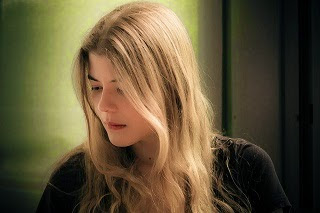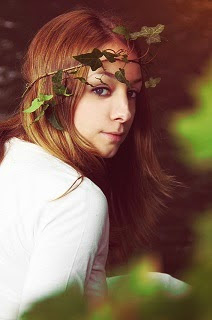
|
| [1] |
Choosing a colour
The first step to bleaching red hair is of course to decide on the result you intend to achieve through lightening. You need to decide on the exact colour you want to achieve before you begin in order to formulate the bleach properly and apply the right colour afterwards.
Once you've found the colour you want, look at how light it is compared to your current colour. Specifically, start by looking at how much lighter it is. Bleach can lift up to 4 - 5 levels with ease in virgin hair, and sometimes as much as 7 - 8 if you're using high quality bleach powder and your hair isn't overly resistant.
Dyed hair, on the other hand, is far more difficult to lighten and it's usual to see a lift of about 3 levels, depending on how many times it has been dyed. If your hair has been previously dyed, you'll need to be more conservative with the new colour you choose, or prepare for the eventuality of having to bleach your hair a second time to get it light enough for your desired shade.

|
| [2] |
Choice of tone
Hair colour has a level, which is how light it is, but it also has another attribute called tone. This can be either cool or warm, and ranges from red to ash. As red is a warm tone and your red hair contains a lot of this warm red tone, you will need to select a shade of toner to neutralise this warmth.
This means that you can't necessarily just apply the exact shade you want. Even if you are making a transition from a dark red colour to a dark golden blonde, you couldn't achieve this by actually using a golden blonde dye.
Doing so would add golden tones to your hair, but it would still look orange because cool tone is required to correct some of the red that would otherwise remain present in the final colour. Bleaching red hair reveals this warmth, and it is necessary for to use toner to correct it to your desired shade.
In order to do this, use an ash dye that is one tone cooler than your desired shade, or select your toner based on this chart:
| Desired shade | Dye to use |
|---|---|
| Ash | Lighten half level further - tone with ash* |
| Natural | Tone with ash |
| Beige | Tone with ash / natural mix |
| Golden | Tone with natural |
| Copper | Tone with golden / copper mix* |
| Lighter Red | Tone with desired red |
*Note: For a full ash result when bleaching red hair, the toner that is used must be applied to hair that has been lightened half a level lighter than the depth you actually want. Otherwise the ash isn't strong enough and produces more of a natural result. You can use a darker ash for proper toning, but this leads to a result that is darker than desired.
Copper results can be made vibrant through the use of the dye mixture in the table above. For a more subtle auburn colour, mix a copper shade with a natural shade and apply this instead. This same method can also be used for red colours where the intention behind bleaching red hair is to reach a lighter red. Pure red dye gives a vibrant result, whilst mixing with a natural tone makes the result more subtle.
Preparing bleach
To prepare your bleach to lighten your hair, the bleach powder must first be mixed with developer. The developer volume you use is dependent on the brand of bleach used.

|
| [3] |
In order to prevent scalp irritation, never use a peroxide strength that is higher than the bleach powder manufacturer's recommended maximum strength for on-scalp use. You can generally use a higher volume for off-scalp highlights, but this should still be done with due care.
The developer also needs to be mixed in a certain ratio. For most bleach powders this ratio is 1:2 powder to developer, meaning that for every one part powder, you need to mix in twice as much developer. This can also vary by brand though and you should use the recommended ratio of your chosen brand for the best results.
| Lightening | Developer to use |
|---|---|
| 1 Level | 10 vol |
| 2 Levels | 20 vol |
| 3 Levels | 20 vol, process longer |
| 4 Levels | 30 vol generic / 20 vol salon |
| 4 - 6 Levels | Salon bleach only - 10 - 20 vol |
| Up to 7 Levels | Salon bleach only - 20 vol |
Applying bleach
Bleaching red hair is best done by sectioning your hair out properly first in order to ensure even results and prevent patches of darker redness in the final colour. To do this, part your hair down the middle from the front of your head to the back of your neck and then part it again from ear to ear, clipping each section up so that you're left with four sections.

|
| [4] |
To apply your bleach, use a tinting brush to apply to small layers of hair on both sides, moving from the top-most layer to the bottom layer of each section and then onto the next section until it's completely covered. Leave it for up to the maximum processing time for your chosen brand and either rinse at desired level or once the maximum time has been reached.
If your hair isn't light enough for your desired colour after the maximum processing time has been reached, you will either have to tone with a darker colour, or apply a second bleach process after allowing your hair to rest for at least a week. Only bleach again if your hair is in good condition and has been allowed to rest.
Toning your hair
After bleaching red hair, toning is necessary to neutralise or enhance upon the remaining red tone left in your hair. Using the chosen shade from the earlier table in this article, apply your toner to sectioned hair and allow this to develop until you reach your desired shade.
For cool tones like ash and natural, this may be reached sooner than the recommended development time. If this is the case, the dye can be removed at that point. It can also be left for a longer duration for a stronger and more vibrant tone.
More information:
- How to bleach hair - Need to lighten your hair at home? Find out how to properly do this for the best results...
- The colour wheel - Discover one of the most useful tools for corrective colour. With it you can tone out any unwanted colour from your hair...
- Removing unwanted dye - Sick of your current colour? Find out how to remove dye and change your hair colour...
Need help bleaching red hair or choosing the right dye to reach your desired shade? Leave a comment for tailored advice...
No comments:
Post a Comment